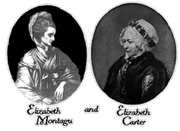
The Bluestocking Archive
This archive has been constructed as a layered series in which related
texts can be situated both simply and complexly. The attempt is to make
clearer the connections between the phenomenon of the original Bluestocking
Circle, the development of sensibility, and the achievements of High Romanticism.
The archive is currently under construction, only those entries with "hotspots"
are completed. Comments and suggestions for revision are welcomed. Please
send correspondence to:
Elizabeth Fay
English Department
UMass Boston
Boston, MA 02125-3393
elizabeth.fay@umb.edu.

A) The Bluestocking Circle: Elizabeth Montagu, Elizabeth
Carter, Catherine Talbot, Elizabeth Vesey, Mary Delany, Hester Chapone
- Elizabeth Carter, Poems on Several Occasions (1762); selected correspondence to Elizabeth
Montagu
- Elizabeth Montagu, An Essay on the Writing and Genius of Shakespeare
(1769); selected
prose and poetry;; Correspondence 1720-1761
- Catherine Talbot, Essays on Various Subjects (1772)
- Hester Chapone, Letters on the Improvement of the Mind (1773)
- Sarah Scott, list discussion of Millenium
Hall (Spring, 1996)
- Eighteenth-century
edited by Jack Lynch

B) Writings that encouraged women's intellectualism
- The Female Right to Literature, tract by Thomas Seward (1748)
- The Feminiad, poem by John Duncombe (1751)
- Mary Wollstonecraft, Thoughts on the Education of Daughters (1787)
- Catherine Macauley, Letters on Education (1790)
- Felicia Hemans and Lucy Aikin on Women's Literary
Tradition
C) Their larger circle
- Hester Thrale, selections from Thraliana (1776-1809)
- Hannah More,
Bas Bleu (1786); Percy (1778)
- Fanny Burney, The Witlings (1779)
- Georgiana, Duchess of Devonshire; The Devonshire House Circle, by Hugh Stokes (1916)
- Ann Yearsley, selections from Poems on Several Occasions (1785):
"Addressed to Sensibility";
Preface to Poems on Various Subjects (1787)
- Frances Reynolds, Enquiry Concerning the Principles of Taste (1789)
- Elizabeth Hamilton, Memoirs of Modern Philosophers (1800)
- Clara Reeve, Progress of Romance (1785)
- Anna Laetitia Barbauld, " A Summer Evening's
Meditation," (1773); selections from Miscellaneous Pieces in Prose
(1773); Eighteen
Hundred and Eleven, A Poem; Selected
Poems, edited by Michael Gamer, UPenn
- Josiah Wedgwood and his pottery
D) Related Circles
D1) The Ladies of Llangollen
- Eleanor Butler and Sarah Ponsonby, selected correspondence
- Elizabeth Smith, Poems, ed. by Harriet Bowdler (selections)
- Lady Louisa Stuart, selections of letters on the Llangollen Ladies
- Anna Seward, Llangollen Vale(1796); extracts from Memoirs of
the Life of Dr. Darwin (1804); letters to Eleanor Butler
- Mary Tighe, Psyche
(1805)
D2) Anna Seward, Swan of Lichfield
-
Seward, "Eyam" and selected sonnets
-
Helen Maria Williams, selections from Letters Written in France
(1790-1794); extracts from Julia, A Novel (1790)
-
Maria Edgeworth, Memoir of Mrs. Elizabeth Hamilton (1816)
-
Thomas Day, The History of Sanford and Merton (1783-89)
D3) Della Cruscans
- The Florence Miscellany (publication which began the Della Cruscan
phenomenon, 1785)
- Hannah Cowley and Robert Merry, Della Cruscan poems
- Mary Robinson, "Ode to Della Crusca" from Poems
(1791); extracts from her Memoirs
- William Gifford, The Baviad (1791)
D4) The Slavery Debate
- Ottobah Cugoano
- Anna Laetitia Barbauld, Epistle
To William Wilberforce, Esq. on the Rejection of the Bill for Abolishing
the Slave Trade.
- Discussion of the Slavery Debate
- Bibliography for the Slavery Debate
E) Predecessor Texts, Related Women Writers, Cultural Contexts, and Late
Romantic Resonances
- David Garrick, Florizel and Perdita (1758)
- Thomas Gray, The Progress of Poesy (1757)
- Ann Radcliffe, The Mysteries of Udolpho
(1794)
- Mary Robinson, Sappho
to Phaon (1796), from University of Virginia; Opening
Passage of the Memoirs of Mary Robinson (1895 edition); A
Letter to the Women of England on the Injustice of Mental Subordination
(1799)
- Joanna Baillie, Introductory Discourse to her Plays on the Passions
(1798); Commentary on De Monfort and Count
Basil
- The French Revolution (relevance to British Romanticism)
- Dorothy Wordsworth, Commentary on Selections from the Journals
- Charlotte Smith, Elegiac Sonnets
- Anna Laetitia Barbauld, selections from British Novelists (1810)
including the prefatory essay, Origin and Progress of Novel Writing
- Mary Shelley, Loves of the Poets (1829)
- Felicia Hemans, Mozart's Requiem (1828);
Felicia
Heman's Page, maintained by Mary Mark Ockerbloom; Felicia
Hemans Chronology, by (Nanora Sweet, U. Missouri, St. Louis)
- Grace
Aguilar (1816-1847)
F) Contemporary Critiques and Subsequent Responses
- Hannah Cowley, The Runaway (1776) Critical Introduction by Angela Escott
- Richard Polwhele, UnSex'd
Females (1798).
- Jane Taylor, Display: A Tale for Young People (1815)
- George Gordon, Lord Byron, The Blues: A Literary
Eclogue (1821).
- Byron, Selected poems from Hours of Idleness
(1807).
- Byron, Don Juan, Canto I (1819)
- Byron, Don
Juan (1819-24), from the University of Toronto .
- Elizabeth Barrett Browning, Essay on Mind (1823).
- Amelia Opie, On some of the most prominent subjects of detraction,
authoresses, bluestockings in Detraction Displayed (1828).
- Charlotte Bronte, Shirley
(1848) (selections indicating the prejudice against intellectual women by
the mid-nineteenth century), from ClassicReader.com.
G) High Romanticism and Sensibility
- Oliver Goldsmith, Selected
Works, from Voice of the Shuttle
- Thomas Gray, Selected
Works from Voice of the Shuttle
- Thomas Chatterton, Selected
Poems (U. Toronto)
- James Macpherson, Fragments
of Ancient Poetry, Collected in the Highlands of Scotland, and Translated
from the Gaelic or Erse Language (1761) (HyperEpos: Epic on the Internet)
- Hannah More, "Sensibility:
An Epistle to the Honourable Mrs. Boscawen" (1782) (Michael Gamer,
U. Penn)
- Helen Maria Williams, "To
Sensibility" (1786) (Stuart Curran, U. Penn)
- Percy Bysshe Shelley, "Ode to the West Wind"
(1820)
- John Keats, "Ode To Psyche" (1819)
- Byron, Manfred (1817)
- Joanna Baillie (1762-1851)
H) Art
- William Hogarth, The
Analysis of Beauty
I) Global Connections
- Bluestockingism in Japan: Feminism in Modern Japan by Vera Mackie
J) Related Websites
- Bluestocking Women Writers in 18th-Century London: Reinventing the Feminine by Katelyn Ludwig
Click here to return to La Belle Assemblée homepage





